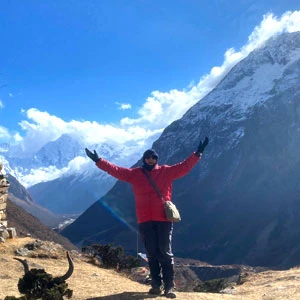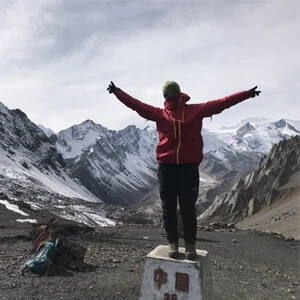Kanchenjunga South Base Camp Trek Difficulty
The Kanchenjunga South Base Camp Trek is a moderately challenging journey. While this trek is comparatively easier than the Kanchenjunga North Base Camp Trek, it still takes you to one of the most remote areas in Nepal. Expect rocky paths, narrow ridges, and steep ascents that test your stamina, especially as you gain altitude.
Rapid Altitude Gain
Starting from a relatively low altitude of 1,000 meters, the route steadily climbs over 4,700 meters in a matter of 6 days. Additionally, for the majority of the trek, you will spend the days above 2,500 meters. Hence, with rapid ascend, you will also notice the thinning of air. While the acclimatization days are included in the itinerary, altitude sickness will still be a looming problem.
Trail Conditions
The routes to Kanchenjunga are far less developed and you will find yourself navigating through steep ascents and descents, rocky terrain, and narrow paths. The higher you climb, the trail may be more concerned with loose rocks, especially near the glacial moraines.
Here, the diverse route will also test your physicality. Your journey initially starts through dense forests of rhododendron, bamboo, and oak, where roots and wet leaves can make the path slippery. Following it, you will walk through the uneven terrain of alpine meadows.
Remoteness
The route to the Kanchenjunga south base camp lies in a remote area with fewer infrastructure and resources. Hence, when needed, emergency evacuation services will be harder to access, which is why trekkers will require to be self-reliant.
Unpredictable Weather
Weather in the Kanchenjunga region is unpredictable, with sudden drops in temperature, especially at night. Even during peak season, the trails that were dry and stable in the morning may face sudden rainfall, making the route muddy and slippery.
Best Time to Trek to Kanchenjunga South Base Camp
The best time to trek to Kanchenjunga South Base Camp is during the Spring (March to May) and Autumn (September to November) seasons. During these months, you will have favorable weather, clear skies, and breathtaking views.
In Spring, the landscape comes alive with vibrant blooms of rhododendrons, magnolias, and other wildflowers. Additionally, the weather is pleasant, with moderate temperatures. Likewise, the trails are relatively dry and manageable, and the visibility is excellent with unobstructed views of the majestic Kanchenjunga range. You may also be able to witness local celebrations such as Chaitra Dashain and Budhha Jayanti.
Moving on, the Autumn season offers crystal-clear skies and cool, stable weather. After the Monsoon rain clears the dust away, it leaves the clearest views of the mountains. Here, daytime temperatures remain comfortable, while nights can drop well below freezing in higher altitudes. Furthermore, the trails are in their best condition. Autumn is also a culturally rich time, with festivals like Dashain and Tihar in full swing. Similarly, the local Limbu and Rai communities are also in celebratory mode as the Chasok Tangnam festival is on the horizon.
Besides these periods, Nepal Trekking Experts do not recommend you to take this journey during off-seasons: Monsoon (June to August) and Winter (December to February). Monsoon season in the lower region brings heavy rainfall which brings a potential risk of landslides and floods while the Winter season brings constant snowfall which results in biting cold temperatures.
Permit Costs For Kanchenjunga Region Trek:
To enter the restricted Kanchenjunga region, you must have a minimum of two people in your group (contact us to join a group), two permits per person, and a trek with a government-licensed guide. When trekking with Nepal Trekking Experts, all permit fees are included in your package. The permit process is more involved in trekking in the Kanchenjunga region compared to others; however, we will process everything and obtain it on your behalf.
- The Kanchenjunga Conservation Area Project Entry Permit (KCAP) costs 2000 Nepali rupees per person with no time restrictions.
- Restricted Area Entry Permit (RAP) for Yamphuding costs 20 USD per person per week.
Tips For a Successful Trek to Kanchenjunga South Base Camp
- Build your stamina and strength through regular cardio, hiking, and strength training at least 5 weeks prior to the trek.
- Keep yourself hydrated by drinking at least 3 liters of water every day.
- Dress up in layers for varying weather conditions.
- Trek during Spring (March to May) or Autumn (September to November) for the best weather, clear mountain views, and safer trails.
- Eat energy-rich meals at teahouses to maintain strength.
- Interact respectfully with the Limbu and Rai communities.
- Pack high-energy snacks to munch on along the trail.
- Avoid smoking and drinking alcohol during ascent.
Transportation To Kanchenjunga South
Before you begin your trek in eastern Nepal, you will initially take a 45-minute domestic flight from Kathmandu to Bhadrapur. Upon landing in Bhadrapur, a 2 to 3-hour drive by bus or jeep takes you to Fikkal Bazar. This drive will be quite refreshing with glimpses of traditional Nepali villages and terraced farmlands. From Phikkal Bazaar, the journey continues with a grueling 8 to 9-hour drive to Taplejung. The next day, it is again followed by a 1.5-hour drive to Yasang.
For the return journey, you will have a 12-hour drive from Yamphudin back to Bhadrapur. Once back in Bhadrapur, the flight to Kathmandu brings you full circle.
Accommodation During the Trek to Kanchenjunga South
Accommodation during the trek to Kanchenjunga South offers a blend of rustic charm and practical simplicity. Teahouses and lodges are the primary options along the trail. Here, the facilities are often simple with rooms providing twin beds and thick blankets. However, do carry your own sleeping bag as the temperature at higher altitudes can be freezing.
As you ascend further into the remote regions, the accommodation becomes more basic. You will generally notice shared bathrooms and limited amenities. Furthermore, the washroom is typically Asian-squat style. As for other facilities such as hot showers, you will have to pay a small fee, and that too, gets more limited as you ascend higher.
Meals During the Trek to Kanchenjunga South
The food options along the trek to Kanchenjunga South are simple, hearty, and energy-packed. Teahouses along the trail offer a mix of Nepali staples and international favorites.
A common meal is dal bhat, the Nepali classic consisting of steamed rice, lentil soup, seasonal vegetables, and pickles. This particular meal comes with unlimited refills. Additionally, some of the other traditional dishes include gundruk (fermented green leafy vegetables), thukpa, sherpa stew, dhido, chowmein, and so on. You will also see items such as noodles, eggs, pasta, and pancakes on the menu. Apart from these, you must also give a try to sel roti, butter tea, and Nepali milk tea.
Telephone Service, Internet, and Battery Charging During the Trek to Kanchenjunga
Telephone Service:
In lower altitudes and more populated areas like Phikkal Bazaar and Taplejung, mobile networks, including NTC and Ncell, provide decent coverage. However, as you ascend into the higher altitudes and more isolated areas like Tortong, Cheram, and Ramche, the network becomes patchy or non-existent.
You will generally find satellite phone services for emergencies in teahouses, but it comes at a premium cost. If you are planning to buy a SIM card for the journey, consider a Nepal Telecom card.
Internet:
Internet access in the Kanchenjunga region is a rare luxury. While you can get the connection in the lower regions like Fikkal Bazar and Taplejung, the service gets scarce in higher altitude levels. Also, some teahouses do offer the wifi service at a cost, but the speed is slow, especially during peak seasons.
Battery Charging:
You will find electricity and solar-powered charging points along the trail. The more you climb, the more you will be paying more fees for this service. Therefore, we recommend you carry a portable power bank.
Porter:
During the Kanchenjunga South Base Camp Trek, you will walk through rugged terrain, steep ascents, and high altitudes that demand physical stamina, and carrying a heavy backpack can take a toll on even the fittest trekkers. Therefore, by hiring a porter, you can offload much of your gear and focus on the stunning surroundings. A single porter will carry around kg of weight in total.
Porters are experienced and familiar with the region and will not only help you relieve your physical load but will also be a cheerful companion. Additionally, hiring a porter for your journey directly contributes to the livelihood of their family and also helps boost the local economy.
Kanchenjunga South Trekking Gear List
Clothing:
- Thermal tops and leggings
- Fleece jacket or sweater
- Waterproof and windproof jacket and pant
- Down jacket
- Quick-drying and moisture-wicking trekking t-shirts
- Moisture-wicking underwear
- Comfortable trekking pants
- Warm insulated gloves
- Beanie
- Scarf
Footwear:
- Waterproof boots with good ankle support
- Lightweight shoes
- Wool or synthetic socks
Gear And Other Equipment:
- 40-60 liters backpack
- Rain cover
- Sleeping bag rated for -10°C to -20°C
- Trekking poles
- Headlamp with extra batteries
- Sunglasses
- Reusable water bottle
- Water purification tablet or filter
- First-aid kit
- Personal medication
- Snacks (including dried fruits, nuts, or energy bars)
- Female hygiene product
- Toiletries (such as toothbrush, toothpaste, wet wipes, toilet paper, hand sanitizer, and quick-drying towel)
- Sunscreen
- Lip balm
Travel Insurance:
Trekking to Kanchenjunga South Base Camp takes you past remote and high-altitude areas which brings the risk of unpredictable weather conditions and altitude sickness. Hence, having comprehensive travel insurance ensures you are covered for emergencies such as evacuation, medical treatment, trip cancellations, or even lost baggage.
When selecting your insurance, make sure it covers high-altitude trekking, ideally up to at least 6,000 meters. Furthermore, look for coverage that includes emergency medical evacuation and trip interruptions due to unforeseen circumstances like strikes, extreme weather, or illness. Altogether, do not forget to carry a photocopy of your travel insurance as well.
Booking and Payment With Nepal Trekking Experts
To book your Kanchenjunga trek with us, you have to send a deposit of 10% of the total cost of the trek. Please also forward a copy of your passport, a passport-sized photo, and full flight details if and when available. For your convenience, you may also forward the deposit to us online through our website. It is completely safe, and as soon as you make it, you will get an automatic receipt in your inbox. The rest of the payment can be paid upon arrival.
If you have any questions, do not hesitate to contact us anytime. We are always ready to assist.



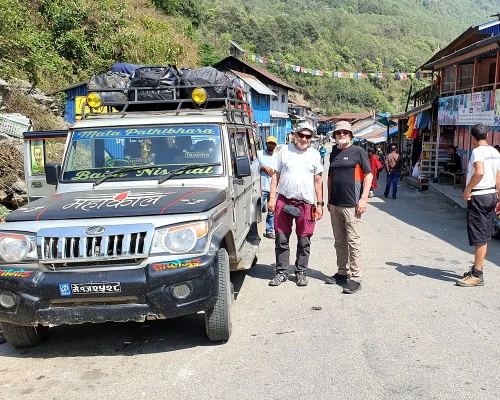
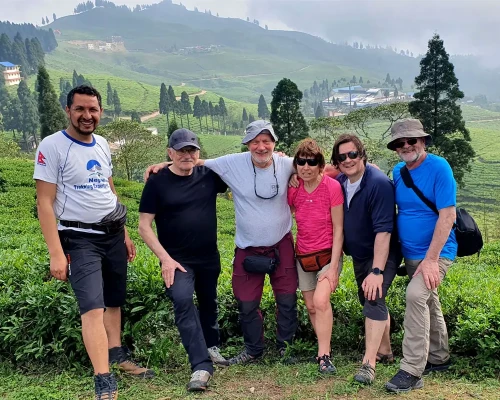
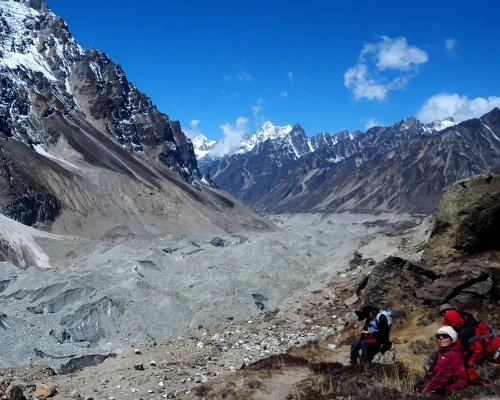
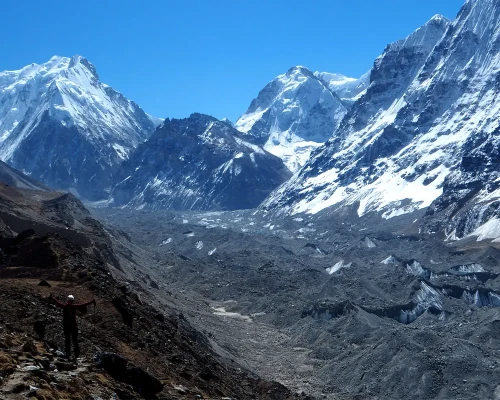

 based on 1 review
based on 1 review

